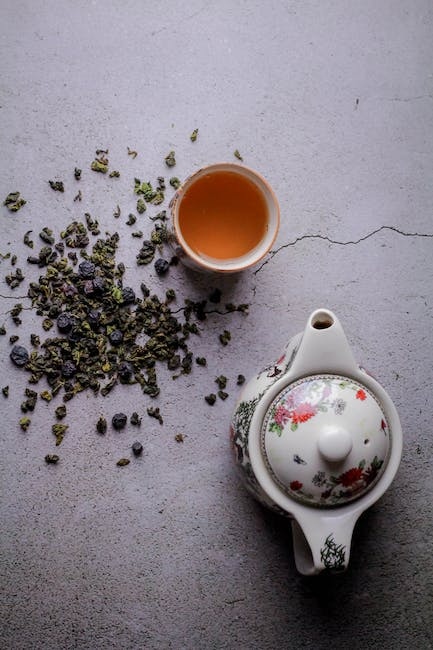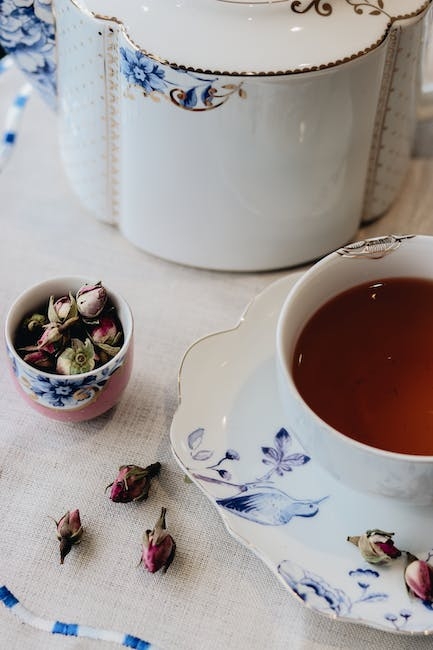Understanding Cholesterol: The Good, The Bad, and The Role of Oolong Tea
Cholesterol is a type of fat molecule that is found in our blood and cells. While it has a bad reputation, cholesterol is essential for our body to function properly. It helps in the production of hormones, digestion of fats, and building of cell membranes. However, not all cholesterol is created equal, and it is important to understand the difference between the good and the bad.
The Two Types of Cholesterol
There are two types of cholesterol: LDL (low-density lipoprotein) and HDL (high-density lipoprotein).
- LDL cholesterol is known as the “bad” cholesterol because it can build up in the arteries and cause blockages, leading to heart disease.
- HDL cholesterol, on the other hand, is known as the “good” cholesterol because it helps to remove excess cholesterol from the bloodstream and prevent blockages.
High levels of LDL and low levels of HDL can increase the risk of heart disease. Therefore, it is essential to maintain a healthy balance between the two.
Lifestyle Factors and Cholesterol Levels
Lifestyle factors such as diet, exercise, and smoking can affect cholesterol levels in the body. A diet high in saturated and trans fats can increase LDL cholesterol levels, while a diet rich in fruits, vegetables, and whole grains can help to lower LDL cholesterol levels.
Regular exercise can also help to increase HDL cholesterol levels and improve overall heart health. On the other hand, smoking can lower HDL cholesterol levels and increase the risk of heart disease.
The Role of Oolong Tea
Oolong tea is a traditional Chinese tea that has gained popularity in recent years due to its potential health benefits. Some studies have shown that oolong tea may help to lower LDL cholesterol levels and improve the ratio of HDL to LDL cholesterol in the body.
One study conducted on 102 volunteers found that those who drank oolong tea for six weeks had significantly lower LDL cholesterol levels compared to those who drank a placebo. Another study found that drinking oolong tea for eight weeks improved the ratio of HDL to LDL cholesterol in overweight and obese participants.
While more research is needed to fully understand the benefits of oolong tea on cholesterol levels, incorporating it into your diet may be a simple and tasty way to help improve your heart health.
Conclusion
Cholesterol is an essential component of our body, but not all cholesterol is created equal. High levels of LDL and low levels of HDL can increase the risk of heart disease. Lifestyle factors such as diet, exercise, and smoking can affect cholesterol levels in the body. Oolong tea has shown potential in lowering LDL cholesterol levels and improving the ratio of HDL to LDL cholesterol. Incorporating oolong tea into your diet may be a simple and delicious way to improve your heart health.
The Amazing Benefits of Oolong Tea on Cholesterol Levels
If you’re looking for a delicious and healthy way to reduce your cholesterol levels, look no further than oolong tea. This traditional Chinese tea has been found to have numerous health benefits, including reducing cholesterol levels in the body.
What is Oolong Tea?
Oolong tea is a type of tea that falls somewhere between green and black tea in terms of oxidation levels. It is made from the leaves of the Camellia sinensis plant, which is also used to make green and black tea. The leaves are partially oxidized before they are dried, giving oolong tea its unique flavor and aroma.
How Does Oolong Tea Reduce Cholesterol Levels?
The antioxidants present in oolong tea, such as flavonoids, thearubigins, and catechins, are believed to be responsible for its positive effect on reducing cholesterol levels in the body. These antioxidants can prevent the oxidation of low-density lipoprotein (LDL), or “bad” cholesterol, which can lead to the buildup of plaque in the arteries.
In addition, oolong tea has been found to increase the production of high-density lipoprotein (HDL), or “good” cholesterol, which helps remove LDL from the bloodstream. This double effect of reducing bad cholesterol while increasing good cholesterol makes oolong tea a powerful tool in the fight against high cholesterol levels.
Studies on Oolong Tea and Cholesterol Levels
A study published in the journal Nutrition found that drinking oolong tea for six weeks led to a significant decrease in LDL cholesterol levels in overweight and obese Chinese individuals.
Another study published in the Journal of Food Science found that consuming oolong tea for four weeks led to a decrease in total cholesterol levels in rats.
While these studies are promising, more research is needed to fully understand the mechanism behind oolong tea’s effect on cholesterol and to determine the optimal amount and frequency of consumption for this benefit.
How to Enjoy Oolong Tea
Oolong tea can be enjoyed hot or cold and can be brewed multiple times from the same tea leaves. To brew oolong tea, bring water to a boil and then let it cool for a minute or two before steeping the tea leaves for 3-5 minutes. Oolong tea can also be blended with other herbs and flavors to create unique and delicious tea blends.
Conclusion
Oolong tea is a delicious and healthy way to reduce cholesterol levels in the body. Its antioxidants can prevent the oxidation of bad cholesterol while increasing good cholesterol, making it a powerful tool in the fight against high cholesterol levels. So why not add a cup of oolong tea to your daily routine and enjoy its many benefits?
How to Brew the Perfect Cup of Oolong Tea
Oolong tea is a delicious and healthy beverage that is enjoyed by many tea enthusiasts around the world. Not only does it have a unique flavor profile, but it also has numerous health benefits, including the ability to lower cholesterol levels. In this post, we’ll go over some tips on how to brew the perfect cup of oolong tea.

Start with High-Quality Tea Leaves
The first step to brewing a delicious cup of oolong tea is to start with high-quality tea leaves. Look for loose-leaf tea rather than tea bags for better flavor and health benefits. Make sure to choose a reputable brand that sources its tea leaves from high-altitude regions where the climate and soil are optimal for tea cultivation.
Use Filtered Water at the Right Temperature
The next step is to use filtered water that is heated to the appropriate temperature. Oolong tea should be brewed with water that is between 180-200F (82-93C). Boiling water can scorch the leaves and affect the taste. It’s also important to note that different types of oolong teas require different water temperatures, so be sure to check the package instructions before brewing.
Measure the Tea Leaves Correctly
Using the correct amount of tea leaves is crucial to brewing a perfect cup of oolong tea. A general rule of thumb is to use 1 teaspoon of tea leaves per 8 ounces of water. However, this can vary depending on the type and quality of tea leaves. Experiment with different amounts to find the perfect ratio for your taste.
Steep the Tea for the Right Amount of Time
Steeping the tea for the appropriate amount of time is also important. Oolong tea should be steeped for 2-3 minutes for the first infusion, and then an additional 30 seconds to 1 minute for each subsequent infusion. Over-brewing can result in a bitter taste, so be careful not to let the tea steep for too long.
Remove the Leaves with a Tea Infuser or Strainer
After the tea has steeped for the appropriate amount of time, it’s important to remove the leaves from the water before drinking. Leaving the leaves in the water can cause the tea to become too strong and bitter. Use a tea infuser or strainer to remove the leaves and enjoy your perfectly brewed cup of oolong tea.
Enjoy the Tea on Its Own or with a Small Amount of Honey or Lemon
Oolong tea has a unique flavor profile that can be enjoyed on its own or with a small amount of honey or lemon for added flavor. Avoid adding milk or cream as this can reduce the tea’s cholesterol-lowering benefits. Sip slowly and enjoy the delicious and healthy beverage.
Conclusion
Brewing the perfect cup of oolong tea takes some practice, but it’s well worth the effort. Not only will you enjoy a delicious and healthy beverage, but you’ll also reap the cholesterol-lowering benefits that oolong tea provides. Remember to start with high-quality tea leaves, use filtered water at the right temperature, measure the tea leaves correctly, steep the tea for the right amount of time, and remove the leaves with a tea infuser or strainer. Enjoy your perfectly brewed cup of oolong tea on its own or with a small amount of honey or lemon, and don’t forget to combine it with other healthy lifestyle choices like exercise and a balanced diet for maximum health benefits.
Discover the Amazing Health Benefits of Oolong Tea
If you’re looking for a flavorful and healthy beverage, oolong tea may be the perfect choice for you. This tea, which is partially fermented, offers a wide range of health benefits that are supported by scientific research. Here are some of the amazing health benefits of oolong tea that you need to know.
1. Oolong Tea Can Help You Manage Your Weight
One of the most impressive benefits of oolong tea is its ability to help you manage your weight. This tea can increase your metabolism and promote fat oxidation, which means that your body will burn calories faster and more efficiently. Additionally, oolong tea contains polyphenols that help prevent the accumulation of fat in your body.
2. Oolong Tea Can Regulate Your Blood Sugar Levels
Another benefit of oolong tea is its ability to regulate your blood sugar levels. This is especially important for people with diabetes, as oolong tea can help reduce insulin resistance and improve glucose tolerance. By drinking oolong tea regularly, you can help prevent the development of diabetes-related complications.
3. Oolong Tea Can Improve Your Cognitive Function and Reduce Stress
Oolong tea has also been found to have cognitive and stress-reducing benefits. The theanine in oolong tea is an amino acid that promotes relaxation and reduces anxiety. Studies have shown that oolong tea can improve cognitive function and reduce stress by lowering cortisol levels in the body.
4. Oolong Tea Can Help Prevent Chronic Diseases
Oolong tea contains antioxidants and anti-inflammatory compounds that can help prevent chronic diseases such as heart disease and cancer. The antioxidants in oolong tea help protect cells from damage caused by free radicals, while the anti-inflammatory properties can help reduce the risk of chronic inflammation.
5. Oolong Tea Can Lower Your Cholesterol Levels
Finally, some studies suggest that oolong tea may help lower cholesterol levels and reduce the risk of cardiovascular disease. By drinking oolong tea regularly, you can help keep your heart healthy and reduce your risk of developing heart-related conditions.
Conclusion
As you can see, oolong tea offers a wide range of health benefits that are backed up by scientific research. Whether you’re looking to manage your weight, regulate your blood sugar levels, reduce stress, prevent chronic diseases, or improve your cognitive function, oolong tea is an excellent choice. To enjoy the full benefits of oolong tea, try incorporating it into your daily routine. Whether you drink it hot or cold, oolong tea is a delicious and healthy beverage that can help improve your overall well-being.


Leave a Reply